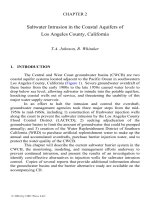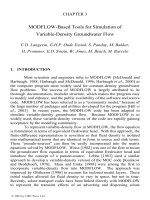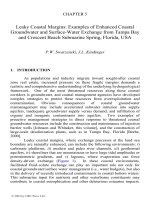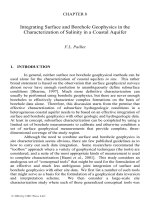Business ethics ethical decision making and case 10e chapter 11
Bạn đang xem bản rút gọn của tài liệu. Xem và tải ngay bản đầy đủ của tài liệu tại đây (6.73 MB, 34 trang )
Part Four
Implementing Business
Ethics in a Global
Economy
Chapter 11
Ethical Leadership
© 2015 Cengage Learning. All rights reserved. May not be copied, scanned, or duplicated, in whole or in part,
except for use as permitted in a license distributed with a certain product or service or otherwise on a password-protected website for classroom use.
1
Defining Ethical
Leadership
Leadership is the ability or authority to guide and direct others toward a
goal
Ethical leadership creates an ethical culture
Positive relationship with the organizational citizenship of employees and a
negative relationship with deviance or misconduct
Have the power to motivate others and enforce the organization’s norms,
policies, and viewpoints
© 2015 Cengage Learning. All rights reserved. May not be copied, scanned, or duplicated, in whole or in part,
except for use as permitted in a license distributed with a certain product or service or otherwise on a password-protected website for classroom use.
2
Defining Ethical
Leadership
In many situations the actions of co-workers profoundly impacts the ethical
decisions of employees
Many CEOs articulate the firm’s core values but fail to exhibit ethical
leadership
A leader must have followers’ respect and also provide a standard of conduct
Failure to demonstrate effective leadership qualities at the top creates the
perception that managers either do not care about the company’s ethics
program or they feel they are above ethics and compliance requirements
© 2015 Cengage Learning. All rights reserved. May not be copied, scanned, or duplicated, in whole or in part,
except for use as permitted in a license distributed with a certain product or service or otherwise on a password-protected website for classroom use.
3
Leaders Admired for
Ethical Conduct
Leaders
Warren Buffett
Howard Schultz
Tony Hsieh
Kenneth Chenault
Company
Ethical Leadership Activities
Promotes ethical conduct as a necessity of business
Berkshire Hathaway
•
•
Offers healthcare to part-time workers
Starbucks
•
•
Creates a fun work environment for employees; encourages employees to make decisions
Zappos
•
•
•
•
Used his strong work ethic to turn around the struggling company
Shares responsibility and decision making with managers of various companies
Developed Create Jobs for USA program to fund small businesses in America
Stresses an environment of quality customer service
Noted for ensuring that stranded cardholders found a way home during the September 11
th
attacks and
approved a $1 million donation to the families of American Express employees lost in the tragedy
American Express
•
Creates a corporate culture in which employees feel appreciated and motivated to perform beyond
expectations
Kip Tindell
The Container Store
•
Employees are provided with better pay and more training than competing retailers
Source: “10 Most Ethical CEOs in America,” Online MBA, March 28, 2012, (accessed April 25, 2013).
© 2015 Cengage Learning. All rights reserved. May not be copied, scanned, or duplicated, in whole or in part,
except for use as permitted in a license distributed with a certain product or service or otherwise on a password-protected website for classroom use.
4
Requirements for
Ethical Leadership
Ethical leadership skills develop through years of training, experience, and learning
other best-practices of leadership
Leadership qualities differ for each situation
Ethical leaders must model organizational values
Place what is best for the organization over their own interests
Train and develop employees throughout their careers
Establish reporting mechanisms
Understand employee values and perceptions
Recognize the limits of organizational rules and values
© 2015 Cengage Learning. All rights reserved. May not be copied, scanned, or duplicated, in whole or in part,
except for use as permitted in a license distributed with a certain product or service or otherwise on a password-protected website for classroom use.
5
Requirements for
Ethical Leadership
Strong ethical leaders are those passionate about the organization and act in
the organization’s best interests
Ethical leadership is highly unlikely without strong personal character
Ethical leaders do not wait for ethical problems to arise
Ethical leaders must model the organization’s values
© 2015 Cengage Learning. All rights reserved. May not be copied, scanned, or duplicated, in whole or in part,
except for use as permitted in a license distributed with a certain product or service or otherwise on a password-protected website for classroom use.
6
Seven Habits of Strong
Ethical Leaders
1.
Ethical leaders have strong personal character.
2.
Ethical leaders have a passion to do right.
3.
Ethical leaders are proactive.
4.
Ethical leaders consider all stakeholders’ interests.
5.
Ethical leaders are role models for the organization’s values.
6.
Ethical leaders are transparent and actively involved in decision
making.
7.
Ethical leaders take a holistic view of the firm’s ethical culture.
© 2015 Cengage Learning. All rights reserved. May not be copied, scanned, or duplicated, in whole or in part,
except for use as permitted in a license distributed with a certain product or service or otherwise on a password-protected website for classroom use.
7
Whole Foods'
Core Values
•
Selling the highest quality natural and organic products
•
Satisfying and delighting our customers
•
Supporting team member happiness and excellence
•
Creating wealth through profits and growth
•
Caring about our communities and our environment
•
Creating ongoing win-win partnerships with our suppliers
•
Promoting the health of our stakeholders through healthy eating education
Source: “Our Core Values,” Whole Foods Markets, www.wholefoodsmarket.com/company/corevalues.php (accessed April 25, 2013).
© 2015 Cengage Learning. All rights reserved. May not be copied, scanned, or duplicated, in whole or in part,
except for use as permitted in a license distributed with a certain product or service or otherwise on a password-protected website for classroom use.
8
Benefits for
Ethical Leadership
Has a direct impact on the corporate culture of the firm
Communicate and monitor an organization’s values, ensuring that employees are
familiar with the company’s purpose and beliefs
Provide cultural motivations for ethical behavior, such as reward systems for ethical
conduct
Can lead to higher employee satisfaction and employee commitment
Creates strong relationships with external stakeholders
Positive association between ethical commitment of employees and a firm’s valuation
on the stock market
© 2015 Cengage Learning. All rights reserved. May not be copied, scanned, or duplicated, in whole or in part,
except for use as permitted in a license distributed with a certain product or service or otherwise on a password-protected website for classroom use.
9
Ethical Leadership and Organizational Culture
Compliance-based approach emphasizes obedience to rules and regulations
and sets processes in place to ensure compliance
Integrity-based approach views ethics as an opportunity to implement core
values
Take responsibility for the firm’s ethical culture and hold employees accountable for
practicing ethical behaviors and core practices
© 2015 Cengage Learning. All rights reserved. May not be copied, scanned, or duplicated, in whole or in part,
except for use as permitted in a license distributed with a certain product or service or otherwise on a password-protected website for classroom use.
10
Ethical Leadership and Organizational Culture
Unethical leaders are usually ego-centric and often do whatever it takes to
achieve the organization’s objectives and their own
Apathetic leaders are not necessarily unethical, but they care little for ethics
within the company
Does not listen to employees and does not communicate well
Ethical leaders include ethics at every operational level and stage of the
decision making process
© 2015 Cengage Learning. All rights reserved. May not be copied, scanned, or duplicated, in whole or in part,
except for use as permitted in a license distributed with a certain product or service or otherwise on a password-protected website for classroom use.
11
Managing Ethical
Conflict
Ethical conflicts occur when there are two or more positions on an
ethical decision
Will not be brought to management’s attention without effective mechanisms
for transparent communication
Employees themselves should be trained to handle conflict situations
© 2015 Cengage Learning. All rights reserved. May not be copied, scanned, or duplicated, in whole or in part,
except for use as permitted in a license distributed with a certain product or service or otherwise on a password-protected website for classroom use.
12
Conflict Management
Styles
Categorize conflict management into five styles: competing, avoiding,
accommodating, collaborating, and compromising
Based on two dimensions:
Assertiveness is acting in one’s own best interests
Cooperativeness means working toward the best interests of the other person
© 2015 Cengage Learning. All rights reserved. May not be copied, scanned, or duplicated, in whole or in part,
except for use as permitted in a license distributed with a certain product or service or otherwise on a password-protected website for classroom use.
13
Conflict Management
Styles
Source: Adapted from Kenneth W. Thomas and Ralph H. Kilmann (March 2, 2010). Thomas-Kilmann Conflict Mode Instrument: Profile and Interpretative Report. © CPP, Inc.
© 2015 Cengage Learning. All rights reserved. May not be copied, scanned, or duplicated, in whole or in part,
except for use as permitted in a license distributed with a certain product or service or otherwise on a password-protected website for classroom use.
14
Conflict Management
Styles
Competing conflict management style: Highly assertive, not very cooperative, believe
in winning at any cost, and measure success by how much the other side loses
Avoiding conflict management style: Not effective because they avoid conflict at any
cost even if it leads to misconduct, are uncooperative, and are non-assertive
Accommodating conflict management style: Highly cooperative, non-assertive, and
give in to the other side even if it means sacrificing their own interests and values
© 2015 Cengage Learning. All rights reserved. May not be copied, scanned, or duplicated, in whole or in part,
except for use as permitted in a license distributed with a certain product or service or otherwise on a password-protected website for classroom use.
15
Conflict Management
Styles
Compromising conflict management style: In between the assertiveness and
cooperativeness dimensions, believe best approach to resolving conflicts is for each
side to give something up in order to gain something of value
Collaborating conflict management style: Most advantageous, leaders are
cooperative and assertive, and leaders collaborate with others to find a creative way to
obtain a beneficial solution
© 2015 Cengage Learning. All rights reserved. May not be copied, scanned, or duplicated, in whole or in part,
except for use as permitted in a license distributed with a certain product or service or otherwise on a password-protected website for classroom use.
16
Ethical Leaders
Empower Employees
Employee empowerment is an essential component of a values-based
organizational culture
Encourages employees to express concerns, bring up ethical issues, and take a
proactive approach toward resolving conflicts
Ethical leadership training for both managers and employees is helpful
Important in creating employee-centered ethical leadership
© 2015 Cengage Learning. All rights reserved. May not be copied, scanned, or duplicated, in whole or in part,
except for use as permitted in a license distributed with a certain product or service or otherwise on a password-protected website for classroom use.
17
Communication for
Becoming A Better Leader
1.
Have the tough conversations that you’ve been meaning to have, including telling people what they need (and not necessarily want)
to hear.
2.
Stop talking and listen more.
3.
Pick up the phone or walk down the hall to actually talk with someone rather than relying on more impersonal emails.
4.
Communicate bad news in the same way, with the same zest, as good news.
5.
Share performance feedback with others regularly so that others know how they can improve.
6.
Be purposeful and thoughtful in how you communicate.
7.
Ask for feedback so you can improve your skills.
8.
Work on your blind spots in your leadership abilities.
Source: Adapted from David K. Grossman, “13 Ways to Become a Better Leader,” The Public Relations Strategist , Winter 2012, pp. 12–13.
© 2015 Cengage Learning. All rights reserved. May not be copied, scanned, or duplicated, in whole or in part,
except for use as permitted in a license distributed with a certain product or service or otherwise on a password-protected website for classroom use.
18
Ethical Leadership
Communication
Transparency and reporting are two major dimensions of ethical
communication
Create transparency by developing a culture where ethics is frequently
discussed
Reporting is a two-way process in which the communicator communicates
with superiors and subordinates
Can be formal or informal
© 2015 Cengage Learning. All rights reserved. May not be copied, scanned, or duplicated, in whole or in part,
except for use as permitted in a license distributed with a certain product or service or otherwise on a password-protected website for classroom use.
19
Four Categories
Of Communication
© 2015 Cengage Learning. All rights reserved. May not be copied, scanned, or duplicated, in whole or in part,
except for use as permitted in a license distributed with a certain product or service or otherwise on a password-protected website for classroom use.
20
Ethical Leadership
Communication Skills
Organizational communication is separated into four categories:
1.
Interpersonal communication is the most well-known form of
communication and occurs when two or more people interact with one
another
Often difficult to communicate to a superior
Ethical leader must work to reassure employees by balancing the interests of all
relevant stakeholders
© 2015 Cengage Learning. All rights reserved. May not be copied, scanned, or duplicated, in whole or in part,
except for use as permitted in a license distributed with a certain product or service or otherwise on a password-protected website for classroom use.
21
Ethical Leadership
Communication Skills
2.
Small group communication is growing in organizations
Can increase collaboration and generate a variety of difficult perspectives and opinions
on a particular issue
Groupthink occurs when one or more group members feel pressured to conform to the
group’s decision even if they personally disagree
Group polarization refers to the fact that a group is more likely to move toward a more
extreme position than the group members might have done individually
© 2015 Cengage Learning. All rights reserved. May not be copied, scanned, or duplicated, in whole or in part,
except for use as permitted in a license distributed with a certain product or service or otherwise on a password-protected website for classroom use.
22
Ethical Leadership
Communication Skills
3.
4.
Nonverbal communication is communication expressed through actions,
body language, expressions, or other forms of communication not written or
oral
Nonverbal cues are deemed more reliable that what he or she states verbally
Listening involves paying attention to both verbal and nonverbal behavior
Without listening, communication becomes ineffective
Good listening skills tend to establish credibility and trustworthiness with employees
© 2015 Cengage Learning. All rights reserved. May not be copied, scanned, or duplicated, in whole or in part,
except for use as permitted in a license distributed with a certain product or service or otherwise on a password-protected website for classroom use.
23
Ways to Avoid Groupthink in
Small-Group Decision Making
1.
Emphasize to each team member that he or she is a “critical evaluator” with the responsibility to express opinions
and objections freely
2.
Eliminate leadership biases by refusing to express an opinion when assigning tasks to a group
3.
Set up a number of independent groups to work on the same issue
4.
Encourage each team member to express the group’s ideas with someone he or she can trust from outside the
group
5.
Express the need to examine all alternatives
6.
Invite outside experts into group meetings, and allow members to interact with these experts
7.
Assign one person to be “Devil’s advocate”
Source: Irving L. Janis (1972). Victims of Groupthink: a Psychological Study of Foreign-Policy Decisions and Fiascos. Boston, MS: Houghton-Mifflin.
© 2015 Cengage Learning. All rights reserved. May not be copied, scanned, or duplicated, in whole or in part,
except for use as permitted in a license distributed with a certain product or service or otherwise on a password-protected website for classroom use.
24
Leader-Follower
Relationships in Communication
Leader-follower congruence occurs when leaders and followers share the
same vision, ethical expectations, and objectives for the company
Leader-exchange theory claims that leaders form unique relationships with
followers through social interactions
Important for ethical leaders to frequently communicate and interact with
employees
© 2015 Cengage Learning. All rights reserved. May not be copied, scanned, or duplicated, in whole or in part,
except for use as permitted in a license distributed with a certain product or service or otherwise on a password-protected website for classroom use.
25









